Contents
function wave
clear all;
close all;
Set time parameters
c = 1.;
t0 = 0.;
tf = 4.;
lt = 200;
dtplot = (tf-t0)/lt;
tspan = t0:dtplot:tf;
lt = length(tspan);
Set space parameters
x0 = -8;
x1 = 8;
ord = 10;
pltord = 8;
xlength = x1-x0;
nord = 2^ord;
dx = xlength/nord;
x = x0+dx*(0:(nord-1));
lx = length(x);
Set initial condition u0 = u(x,0), u_t0 = u_t(x,0)
u0 = uzero(x,lx);
u_t0 = utzero(x,lx);
U0 = [u0,u_t0].';
figure(1)
plot(x,u0,'b-',x,u_t0,'r-')
xlabel('x'); ylabel('u, u_t');
title('Initial data for u (blue) and u_t (red)')
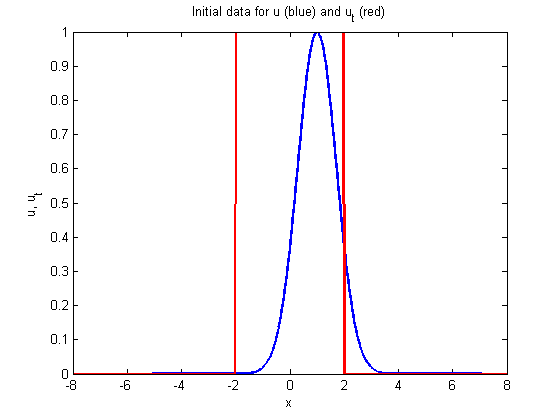
Solve the equation
options = odeset('AbsTol', 1.0e-6, 'RelTol', 1.0e-3);
[t, U] = ode45(@fw,tspan,U0,options,c,lx,dx);
Plot the solution
nwater=1; ncontour=1; nenergy=1; nmovie=0; ngraph=1;
u = U(:,1:lx);
u_t = U(:,lx+1:2*lx);
umax = max(max(u));
umin = min(min(u));
pltord = min(pltord,ord);
dxplot = 2^(ord-pltord);
nxplot = 1:dxplot:lx;
xplot = x(nxplot);
uplot = u(:,nxplot);
Surface plot
if (nwater==1)
figure(2);
waterfall(xplot,t,uplot)
view(10,70)
axis tight
xlabel('x'), ylabel('t'), zlabel('u')
title('Waterfall plot for u(x,t)')
grid off
end
if (ncontour==1)
figure(3); clf;
contour(xplot,t,uplot,40)
xlabel('x'), ylabel('t'), title('Contour plot for u(x,t)')
end
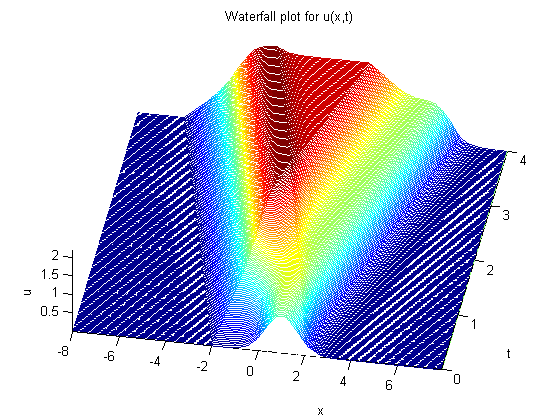
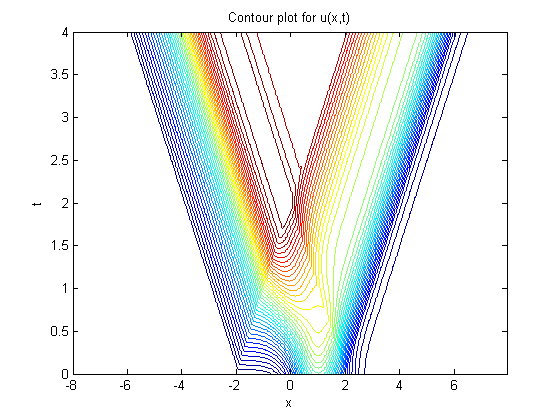
Energy plot
if (nenergy==1)
figure(4); clf;
e=zeros(1,lt);
for j=1:lt
uj = u(j,:);
ujp = circshift(uj.',1).';
ujx = (ujp - uj)/dx;
ujt = u_t(j,:);
e(j) = 0.5*dx*(sum(ujt.^2) + c^2*sum(ujx.^2));
end
plot(t,e);
emax=max(0,1.2*max(e)); emin = min(0,1.2*min(e));
axis ([t0 tf emin emax]);
title('Energy: E = (1/2) \int (u_t^2 + c^2 u_x^2) dx');
xlabel('t'); ylabel('E');
end
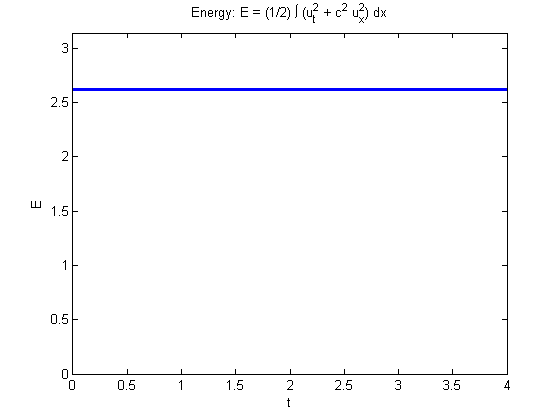
Movie plots
if (nmovie==1)
textx = x1 - (x1-x0)/4;
textu = umax - (umax-umin)/10;
figure(5);
mvplotu=moviein(lt);
hold off;
for jj = 1:lt
umplot = u(jj,:);
plot(x,umplot);
axis([x0 x1 umin umax]);
xlabel('x'); ylabel('u');
text(textx,textu,strcat('time = ',num2str(t(jj))));
mvplotu(jj) = getframe(gcf);
end
movie2avi(mvplotu,'u.avi',...
'fps',25,'quality',100,'compression','None');
end
Solution at different times
if (ngraph==1)
j1 = round(lt/4); j2 = round(lt/2); j3 = round(3*lt/4);
t0 =t(1); t1 = t(j1); t2 = t(j2); t3 = t(j3); t4 = t(lt);
figure(6);
plot(x,u(1,:),'b',x,u(j1,:),'g',x,u(j2,:),'r',...
x,u(j3,:),'m',x,u(lt,:),'k');
xlabel('x'); ylabel('u');
axis([x0 x1 umin umax]);
title(['t = ',num2str(t0),' (blue), ',...
num2str(t1),' (green), '...
num2str(t2),' (red), '...
num2str(t3),' (magenta), '...
num2str(t4),' (black)'])
end
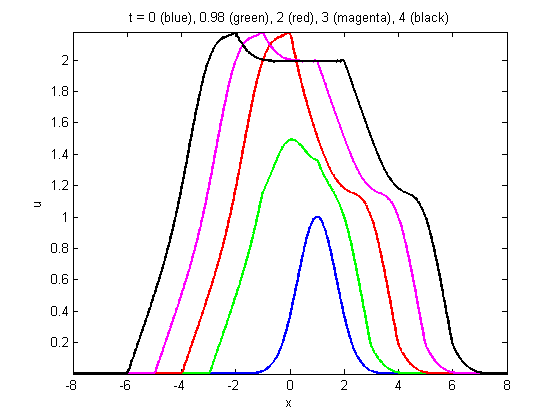
end
Right-hand side of ODE for wave equation
function U_t = fw(~,U,c,lx,dx)
u = U(1:lx);
u_t = U(lx+1:2*lx);
up = circshift(u,1);
un = circshift(u,-1);
du = u_t;
du_t = c^2*(up - 2*u + un)/dx^2;
U_t = [du; du_t];
end
Initial data for u
function u0 = uzero(x,lx)
u0 = 0.*x;
for ii=1:lx
if (x(ii)>-3) && (x(ii) < -2)
u0(ii) = x(ii)+3;
elseif (x(ii)>=-2) && (x(ii) < -1)
u0(ii) = -1-x(ii);
elseif (x(ii)>2) && (x(ii) < 3)
u0(ii) = x(ii)-2;
elseif (x(ii)>=3) && (x(ii) < 4)
u0(ii) = 4-x(ii);
else
u0(ii) =0.;
end
end
u0 = exp(-(x-1).^2);
end
Initial data for u_t
function u_t0 = utzero(x,lx)
u_t0 = 0.*x;
for ii=1:lx
if (x(ii)>-2) && (x(ii) < 2)
u_t0(ii) = 1.;
else
u_t0(ii) = 0.;
end
end
end




